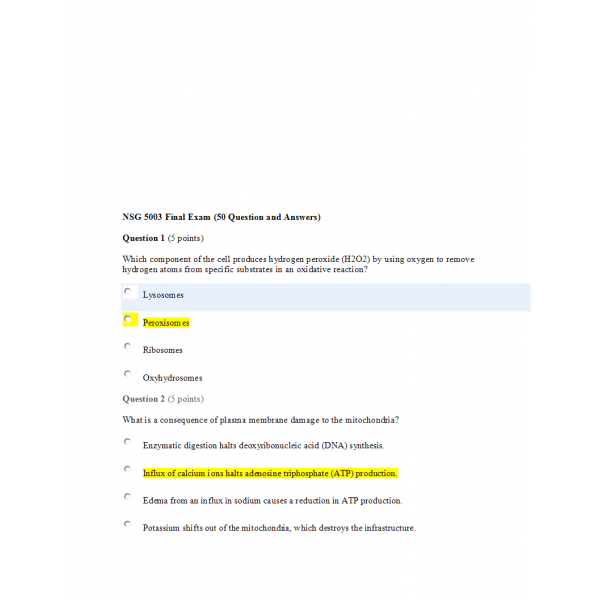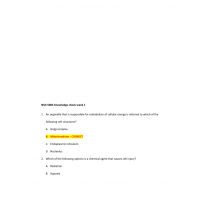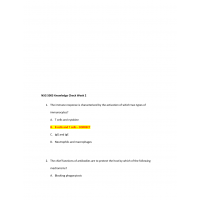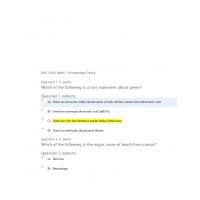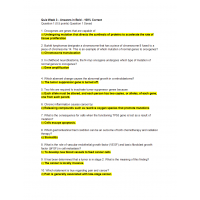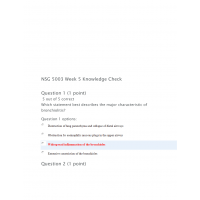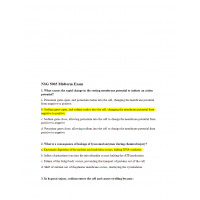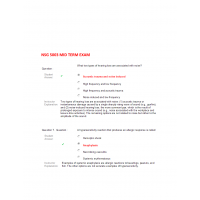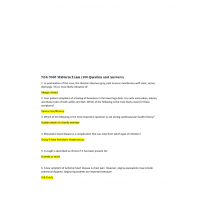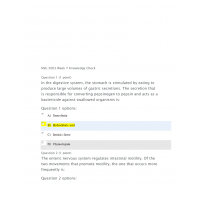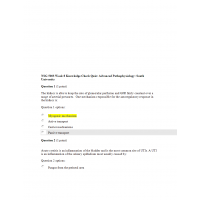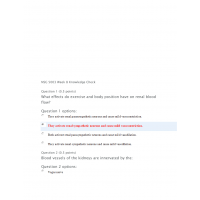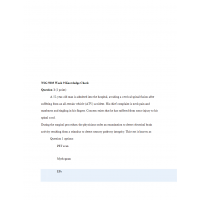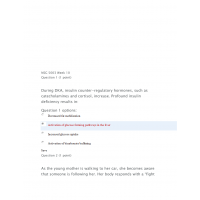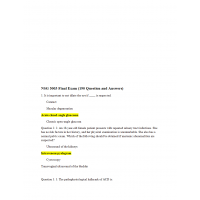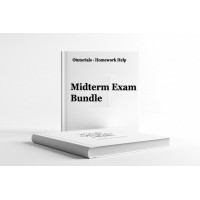NSG 5003 Final: Advanced pathophysiology: South University
Question 1 (5 points) Which component of the cell produces hydrogen peroxide (H2O2) by using oxygen to remove hydrogen atoms from specific substrates in an oxidative reaction?
Question 2 (5 points) What is a consequence of plasma membrane damage to the mitochondria?
Question 3 (5 points) Which statement is a description of one of the characteristics of apoptosis?
Question 4 (5 points) During cell injury caused by hypoxia, sodium and water move into the cell because:
Question 5 (5 points) What is an effect of ionizing radiation exposure?
Question 6 options: chapter 3 q.2 ?Adipose cells contain little water because fat is water repelling. The metabolic rates of obese adults are slower than those of lean adults. The rates of urine output of obese adults are higher than those of lean adults. The thirst receptors of the hypothalamus do not function effectively.
Question 7 (5 points) In addition to osmosis, what force is involved in the movement of water between the plasma and interstitial fluid spaces?
Question 8 (5 points) Venous obstruction is a cause of edema because of an increase in which pressure?
Question 9 (5 points) At the arterial end of capillaries, fluid moves from the intravascular space into the interstitial space because:
Question 10 (5 points) It is true that natriuretic peptides:
Question 11 (5 points) What causes the clinical manifestations of confusion, convulsions, cerebral hemorrhage, and coma in hypernatremia?
Question 12 (5 points) A major determinant of the resting membrane potential necessary for the transmission of nerve impulses is the ratio between:
Question 13 (5 points) In hyperkalemia, what change occurs to the cells’ resting membrane potential?
Question 14 (5 points) Physiologic pH is maintained at approximately 7.4 because bicarbonate (HCO3) and carbonic acid (H2CO3) exist in a ratio of:
Question 15 (5 points) Increased capillary hydrostatic pressure results in edema because of: Question 16 (5 points) Hypomethylation and the resulting effect on oncogenes result in: Question 17 (5 points) The functions of the major histocompatibility complex (MHC) and CD1 molecules are alike because both:
Question 18 (5 points) The B-cell receptor (BCR) complex functions uniquely by:
Question 19 (5 points) The generation of clonal diversity includes a process that:
Question 20 (5 points) Vaccinations are able to provide protection against certain microorganisms because of the:
Question 21 (5 points) What is the mechanism that results in type II hypersensitivity reactions?. Question 22 (5 points) When soluble antigens from infectious agents enter circulation, tissue damage is a result of:
Question 23 (5 points) ? Considering the hypothalamus, a fever is produced by:
Question 23 options: a) Endogenous pyrogens acting directly on the hypothalamus b) Exogenous pyrogens acting directly on the hypothalamus c) Immune complexes acting indirectly on the hypothalamus d) Cytokines acting indirectly on the hypothalamus Question 24 (5 points) Vaccines against viruses are created from:
Question 24 options: a) Killed organisms or extracts of antigens b) Live organisms weakened to produce antigens c) Purified toxins that have been chemically detoxified d) Recombinant pathogenic protein
Question 25 (5 points) Carcinoma in situ is characterized by which changes?
Question 26 (5 points) Two “hits” are required to inactivate tumor-suppressor genes because:
Question 27 (5 points) What is the skin-related health risk induced by some types of chemotherapy? Question 27 options: a) Infection b) Ultraviolet damage c) Pain d) Erythema
Question 28 (5 points) When a child is diagnosed with cancer, which intervention has the greatest influence on the child’s mortality rate?
Question 29 (5 points) Reflex activities concerned with the heart rate, blood pressure, respirations, sneezing, swallowing, and coughing are controlled by which area of the brain? Question 30 (5 points) The edema of the upper cervical cord after a spinal cord injury is considered life threatening because of which possible outcome?
Question 31 (5 points) What term is used to describe the complication that can result from a spinal cord injury above T6 that is producing paroxysmal hypertension, as well as piloerection and sweating above the spinal cord lesion?
Question 32 (5 points) Atheromatous plaques are most commonly found:
Question 33 (5 points) Multiple sclerosis is best described as:
Question 34 (5 points) Graves disease develops from:
Question 35 (5 points) Pathologic changes associated with Graves disease include:
Question 36 (5 points) A patient diagnosed with diabetic ketoacidosis (DKA) has the following laboratory values: arterial pH 7.20, serum glucose 500 mg/dl, positive urine glucose and ketones, serum potassium (K ) 2 mEq/L, and serum sodium (Na ) 130 mEq/L. The patient reports that he has been sick with the “flu” for a week. What relationship do these values have to his insulin deficiency?
Question 37 (5 points) Type 2 diabetes mellitus is best described as:
Question 38 (5 points) The common hay fever allergy is expressed through a reaction that is mediated by which class of immunoglobulins?
Question 40 (5 points) Hypoglycemia, followed by rebound hyperglycemia, is observed in those with:
Question 41 (5 points) Which structure is lined with columnar epithelial cells
Question 43 (5 points) Which statement best describes a Schilling test?
Question 44 (5 points) In aplastic anemia (AA), pancytopenia develops as a result of which of the following?
Question 45 (5 points) Which statement is true regarding warm autoimmune hemolytic anemia? Question 46 (5 points) Hemolytic disease of the newborn (HDN) can occur if the mother: Question 47 (5 points) When diagnosed with hemolytic disease of the newborn (HDN), why does the newborn develop hyperbilirubinemia after birth but not in utero?
Question 48 (5 points) How does angiotensin II increase the workload of the heart after a myocardial infarction (MI)?
Question 49 (5 points) What event is a characteristic of the function in Zone I of the lung? Question 50 (5 points) What factor associated with gluten-sensitive enteropathy (celiac sprue) causes an infant to bruise and bleed eas
| Institution & Term/Date | |
| Term/Date | South University |
NSG 5003 Week 11 Final Exam 1
- Product Code: 2019
- Availability: In Stock
-
$35.00

